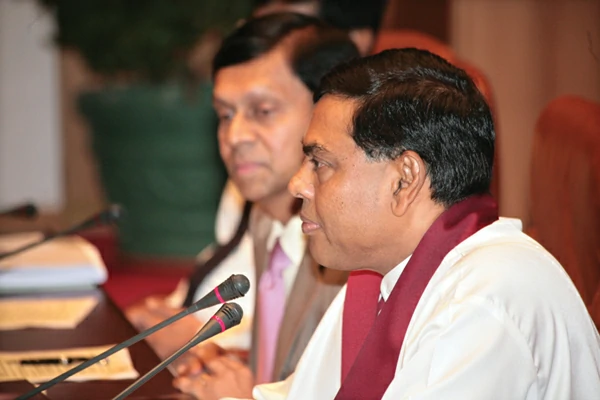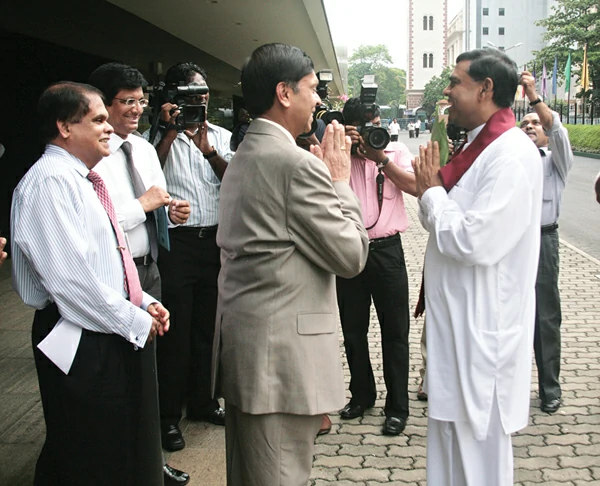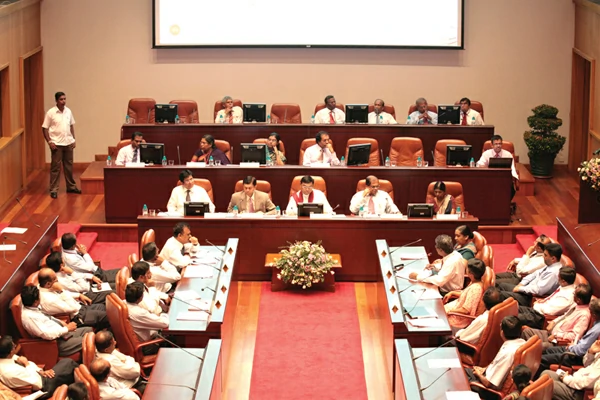
Minister of Economic Development, Basil Rajapaksa, visited the Central Bank of Sri Lanka. Speaking during the occasion, Ajith Nivard Cabraal, Governor of the Central Bank said that the Bank aims to increase the per capita income of the country and stated that a long-term plan has been adopted to meet this end.
Presentations were made by Senior Officials of the Central Bank. Following are some of the key points that were covered: It is the responsibility of the Central Bank to create an environment feasible for economic development. The Central Bank hopes to reduce economic malfunctions, ensure the General publics’ economic prosperity, elevate their lifestyle, drive economic representatives to act with a broader and a long-term vision, and establish public trust in the monetary system.
It is important to take measures to increase savings and to utilise them efficiently for production purposes. Regarding the stability of the monetary system, it was mentioned that there are a number of objectives to be achieved and that the Central Bank of Sri Lanka acts to achieve long-term economic development. It was also highlighted that to maintain the stability of the monetary system, it is necessary to regulate and supervise licenced commercial banks, licenced specialised banks, registered finance companies and registered finance leasing establishments. In addition, primary dealers of government securities should be regulated and supervised to prevent instability by recognising risks and fluctuations of the monetary system at the first stage.
Last year and the year before Sri Lanka faced crises; the global financial crisis, which affected our economy and the war situation, which intensified, affecting the economy. Simultaneously, in the international arena large financial institutions suffered heavy losses. Even locally certain financial institutes faced setbacks. Therefore, the Central Bank had to take measures to protect the financial system. Despite these difficulties in 2009, the Sri Lankan economy recorded a 3.5% decrease in inflation. This is a commendable development as most countries recorded negative economic growth and it is also noteworthy that Sri Lanka achieved an economic growth of 3% despite the challenges. In the first quarter of last year an economic growth of 1.5% was recorded. After regaining peace, the economy recovered rapidly and the Sri Lankan economy maintained an accelerated economic growth. This growth rate is expected to remain. The first quarter of the 2010 economic growth is expected to record around 7% or higher. When compared to earlier years, during these four years we have achieved a growth of 6% or higher.
Growth is visible in all sectors. In agriculture, rubber and coconut, production has increased. In the manufacturing sector food and goods production has increased mainly because local demand has increased. After the North and the East regained peace the demand from those areas increased. This resulted in the progress of the manufacturing sector in the second half of 2009. There is also growth in the telecommunication, banking, financial and transportation areas in the services sector.
It was also noted that to maintain a growth rate of 7% or more, there should be an increase in investments to 30% or more and for this purpose, savings should be increased. Increase in savings would improve the investment rate. In 2008 the lowest unemployment rate of 5.4% was recorded in the North. Though with the economic activities slowing down in 2009 the unemployment rate increased in the third and fourth quarters. As the economy recovered, in 2009, unemployment decreased.
THE CONTINUOUS POLICY OF THE CENTRAL BANK REGARDING THE EXCHANGE RATE HAS BEEN TO PREVENT FLUCTUATIONS IN THE EXCHANGE MARKET.
The external sector was affected because of the global crisis. During the global economic crisis, foreign investment, especially short-term investment declined. Consequently monetary reserves decreased and affected the exchange rate. However, in the second quarter the external sector recovered rapidly. Till 2008, remittances were less than the balance of payment. In 2009, remittances were more than the balance of payment and Sri Lanka received Rs 3.3 billion remittances in 2009.
It was also mentioned that the continuous policy of the Central Bank regarding the exchange rate has always been to prevent fluctuations in the exchange market. In order to build foreign reserves, the Central Bank intervene in the exchange market. In the first quarter of 2009 the exchange rate was affected because of the effect on the external sector.
The Government income has decreased during the past few years. This was 16.3% from the GDP in 2006, and in 2009 it was 16.4%. To increase this, it is necessary to implement and strengthen tax policies and management. In 2009 Rs 271 billion was spent on salaries, Rs 310 billion on interest payments, Rs 85 billion on pensions and Rs 213 billion for others, which add up to a total of Rs 879 billion. It is 73% out of the whole expenditure. As a percentage of the whole income, it is 135%. This indicates that the Government income is not adequate to pay the Government expenditure. Due to this situation the Government is compelled to borrow money to settle the expenses.
When taken as a percentage of the GDP, the budget deficit in 2008 was 7.7%. It was 9.8% in 2009 though the aim of the Government was to keep it at a level of 7%. This was a result of the increase in Government expenditure due to increased investments in the North and East. Even globally, the budget deficit increased in most countries. In countries like America, it was as high as 12%.
Sri Lanka has consistently paid off its debts during the past 60 years. The debt that has increased during the past 60 years, have amounted to Rs 4161 billion at present. The loan amount per capita has overrun Rs 200,000. It has happened because the Government has been managed with a minus budget during the past 60 years and also because the rupee has been devalued. Our debts increased from Rs 1,219 billion in 2000 to Rs 4,161 billion in 2009. From our Government debt 42% is local debt. Out of foreign debt, 28% is trade debt. These have been obtained as 72% easy payment loans. Out of the whole debt, 23% is short-term debts and 77% are long-term debts. Now our loan interest is less than 10%. This figure is very important to manage Government debts. Inflation and interest rate go together. Therefore, if inflation can be controlled, it will be good for the interest rate.
The responsibility of the Central Bank is to stabilise prices and a monetary policy is needed for this. It is imperative to change the cash flow and the interest rate to change this situation. The idea of this process is to keep a stable and low inflation rate in the country. Through this the stability of the financial sector and development of the economy is expected.
Looking back at the country’s monetary policy, Sri Lanka’s monetary policy until 2001 was very tough. Later it was loosened and consequently, loans increased and inflation rose in 2006 and 2007. Due to this, it was decided that the monetary policy should be tough and after the change of these policies, inflation dropped from June 20, 2008 until now.
At present there are 22 commercial banks and 17 licensed specialised banks in the country. In the future, six provincial banks will merge into one and the assets of these will override Rs 3,000 billion. It is expected to make a considerable change in the economy of this country and to contain financial stability.
Regarding banks, interest rate is the key topic and it is important to maintain interest levels at a low level and that the Central Bank is taking this into consideration. When the interest rates are low, it makes it easier to obtain loans, which in turn results in increasing inactive loans. The Central Bank plans to change this situation by making changes to its reserves. Plans are underway to set up a strong banking system in the North and East as well.
Discussing the importance of development of infrastructure, it was stated that the aim is to accelerate the development process of the country. Through this, certain facilities will be upgraded and maintained while education and health sectors are being developed. It was also pointed out that during the past five years, 5% of the GDP was allocated to develop infrastructure. The final outcome of programmes such as Maga Neguma, Gama Neguma, Negenahira Navodaya, and Uthuru Wasanthaya will enable faster infrastructure development, which will help the country develop.
Addressing the officials of the Central Bank, Minister of Economic Development Basil Rajapaksa stated that during the past Presidential Election and the General Election the people of this country gave an immense support to the President and the UPFA. This is a greater mandate than what the President received in 2005. These people have huge expectations. “They gave us an immense power and we have a great responsibility and task ahead to keep up to their expectations. We know that the President used the mandate he gained in 2005 mainly to end the inhuman terrorist activities that persisted for 30 years. With this new victory the President aims to make Sri Lanka a developed country and remove the tag the country had for 60 years as an ‘underdeveloped country,” he said.
The Minister also pointed out that the Ministry of Economic Development, together with the Central Bank has an immense task in eradicating poverty, developing areas and infrastructure. He stated that, working together, the Ministry expects the Central Bank to show the way to go forward. “That is a massive task. As politicians we have to take immediate decisions when the general public have requirements. But what we expect from the Central Bank is to think and plan ahead and identify the requirements of the public and come up with suggestions,” he said.
Outlining some of the duties of the Economic Development Ministry, Minister Rajapaksa said that the Ministry undertakes different tasks. The banking system, non-banking institutions and currency management are done by the Central Bank. Apart from the main framework, even industries such as Tourism and Zoological Gardens come under the Economic Development Ministry as a result of cutting down the number of Ministries. He also stated that the Ministry of Economic Development has to work together with the rural economic sector, the tourism sector, the International Monetary Fund (IMF), North and East projects, the Presidential Task Force and other ministries. He urged the Central Bank to get together with the Ministry to take on the future tasks in a positive manner.
The Minister said, “the Central Bank has a huge task. It is a very difficult task. We faced a great struggle economically in the past period. During this time, as politicians we concentrated mainly on terrorism. You were involved with us in this task, understood the situation and gave us your fullest support. You have the respect and thanks of the Government and the people of this country because of this.” Especially in the future, the Ministry of Economic Development together with the Central Bank has the great task of eradicating poverty, developing areas, and developing infrastructure, stated the Minister.







